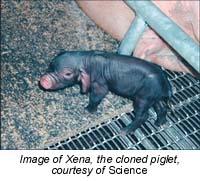Cloned pigs produced on two continents
 Two groups reported in last week's Science and Nature on the successful cloning of pigs in what may be the first steps in the production of animals for xenotransplantation. Xena, the cloned pig (see picture) was produced by scientists at the National Institute of Animal Husbandry in Japan, using methodology developed by scientists at the University of Honolulu (see related story). And halfway around the world, scientists at PPL Therapeutics (Blacksburg, VA and Roslin, UK) created five pigs cloned from granulosa cell genetic material.
Two groups reported in last week's Science and Nature on the successful cloning of pigs in what may be the first steps in the production of animals for xenotransplantation. Xena, the cloned pig (see picture) was produced by scientists at the National Institute of Animal Husbandry in Japan, using methodology developed by scientists at the University of Honolulu (see related story). And halfway around the world, scientists at PPL Therapeutics (Blacksburg, VA and Roslin, UK) created five pigs cloned from granulosa cell genetic material.
PPL Therapeutics scientists made several modifications of procedures that worked well with other species in order to improve the efficiency of pig cloning, which was, prior to this report, in the 1–2% range. As reported in the August 17 issue of Nature, Irina Polejaeva and colleagues used a two-stage nuclear transfer method–in the first stage, nuclei from pooled granulosa cells, cultured only briefly, were fused to enucleated oocytes; in the second, the pronuclei from the fused oocytes were transplanted to enucleated zygotes. Then, to overcome low developmental rates, up to 100 embryos were implanted in surrogate mother pigs.
Of the seven pigs that received implants, two became pregnant, and one carried the fetuses to term, giving birth to five piglets. Of these, three pigs were shown by microsatellite analysis to be derived from one type of granulosa cell and two from a second.
The researchers attribute their success to the avoidance of several steps that are typically inefficient, such as activation procedures and culturing procedures. They are currently preparing to create pigs lacking a1,3 galactosyl transferase, the enzyme that adds xenogenic sugars to cell surface proteins. Creating pigs lacking this activity should lessen the rejection after xenotransplantation.
Zena, a female piglet, was cloned by microinjecting genetic material from fetal pig skin cells into enucleated eggs, a procedure used by Teruhiko Wakayama and colleagues at the University of Honolulu to clone mice.
Lead author Akira Onishi and coauthors suggest that this quick and clean insertion may be key to Xena's successful birth. Their method transfers only the genetic material from the fetal donor cell, rather than the entire donor cell, which was the case when Dolly, the famous cloned sheep, was created.
"With microinjection, you can be quite selective about the genetic transfer," says co-author Anthony C.F. Perry of the Rockefeller University. "You can separate the chromosomes out, and avoid contaminating the egg with the rest of the material from the donor cell nucleus."
After stimulating the injected eggs with an electrical pulse and allowing them to mature into early-stage embryos, researchers who reported in Science transplanted the embryos into four surrogate mothers. Healthy and apparently normal, Xena was the one birth from 110 transplanted embryos.
Xena, which was cloned from cells from a strain of black pigs, has a black coat that contrasts sharply with the white coat of her surrogate mother. However, to confirm that Xena was a clone, the researchers did genetic fingerprinting of Xena, the surrogate, and the donor cell line.
For more information on the Science paper, contact Heather Singmaster at 202-326-6440 or hsingmas@aaas.org. For more on the Nature paper, contact Irina A. Polejaeva of PPL Therapeutics at ipolejaeva@ppl-therapeutics.com.
Edited by Laura DeFrancesco
Managing Editor, Bioresearch Online
